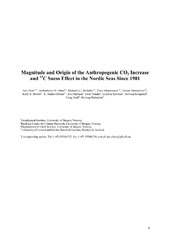Magnitude and Origin of the Anthropogenic CO2 Increase and the 13C Suess Effect in the Nordic Seas since 1981
Olsen, Are; Abdirahman, Omar M.; Bellerby, Richard G. J.; Johannessen, Truls; Ninnemann, Ulysses Silas; Brown, Kelly R.; Olsson, K. Anders; Olafsson, Jon; Nondal, Gisle; Kivimäe, Caroline; Kringstad, Solveig; Neill, Craig; Olafsdottir, Solveig
Peer reviewed, Journal article
Accepted version
Permanent lenke
https://hdl.handle.net/1956/2090Utgivelsesdato
2006-09-29Metadata
Vis full innførselSamlinger
- Geophysical Institute [1198]
Originalversjon
https://doi.org/10.1029/2005gb002669Sammendrag
This study evaluates the anthropogenic changes of CO2 (∆Cant) and δ13C (∆δ13Cant) in the Nordic seas, the northern limb of the Atlantic Meridional Overturning Circulation, that took place between 1981 and 2002/03. The changes have been determined by comparing data obtained during the Transient Tracers in the Ocean, North Atlantic Study (TTO-NAS) with data obtained during the Nordic seas surveys of R/V Knorr in 2002 and R/V G.O. Sars in 2003 using an extended multi-linear regression approach. The estimated ∆δ13Cant and ∆Cant and their relationship to each other and to water mass distribution suggest that the Polar Water entering the Nordic seas from the north is undersaturated with respect to the present atmospheric anthropogenic CO2 levels and promotes a local uptake of Cant within the Nordic seas. In contrast, the Atlantic Water entering from the south appears equilibrated. It carries with it anthropogenic carbon which will be sequestered at depth as the water overturns. This pre-equilibration leaves no room for further uptake of Cant in the parts of the Nordic seas dominated by Atlantic Water. The upper ocean pCO2 in these regions appears to have increased at a greater rate than the atmospheric pCO2 over the last two decades; this is reconcilable with a large lateral advective supply of Cant.
